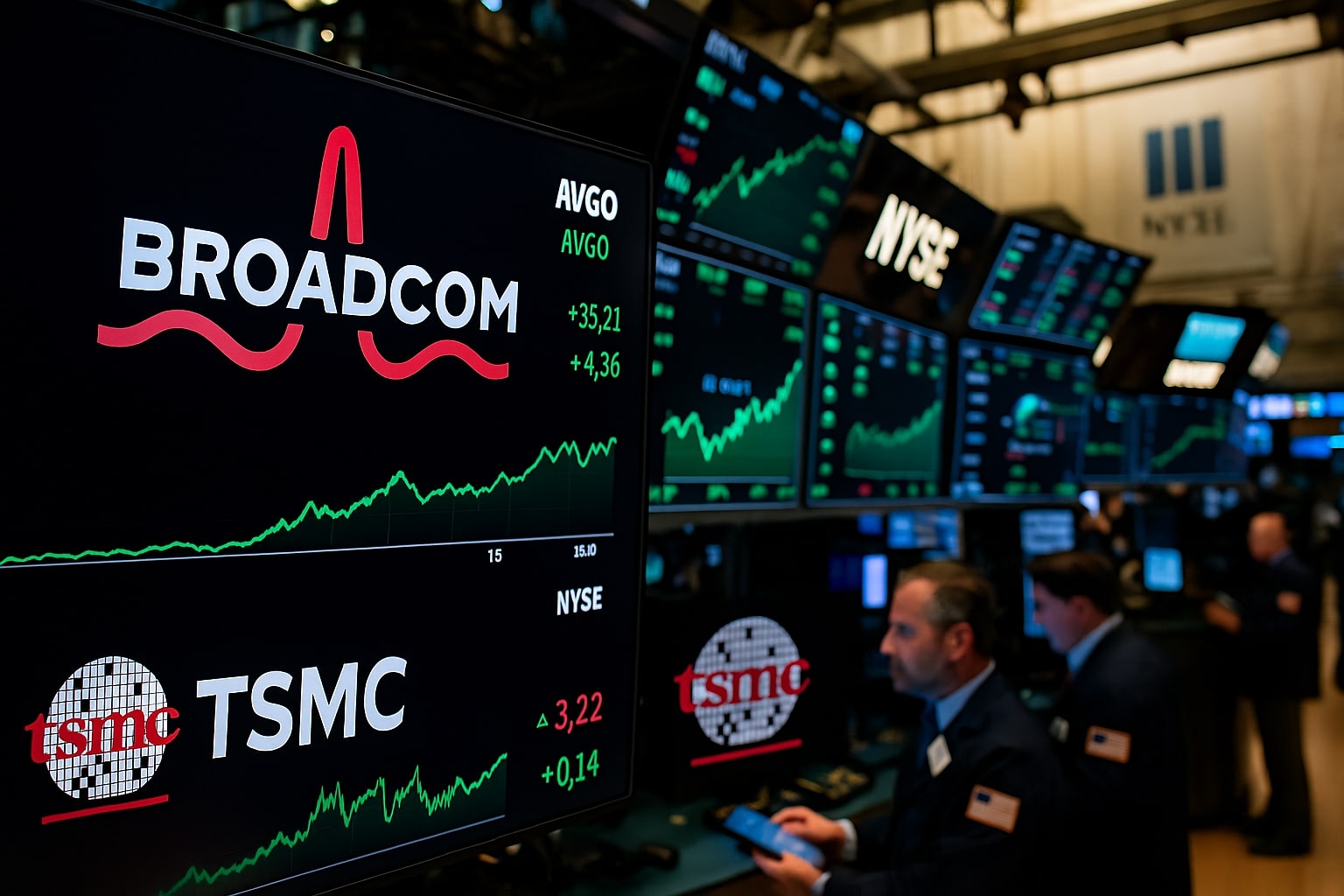
Broadcom Stock (NASDAQ:AVGO) vs. Taiwan Semiconductor Stock (NYSE:TSM): Which Stock Leads the AI Race?
AVGO trades near $296 with AI revenue surging, while TSM at $226 powers Nvidia and Apple. Both eye $300+, but valuations and risks diverge | That's TradingNEWS
Broadcom (NASDAQ:AVGO) Versus Taiwan Semiconductor (NYSE:TSM): Two AI Giants Under Pressure and Growth
NASDAQ:AVGO stock performance and valuation
Broadcom Inc. (NASDAQ:AVGO) is trading at $295.79, down about 0.54% on the session, with a market cap of $1.39 trillion and a 52-week range of $134.90–$317.35. The stock has gained 94.6% in the past 12 months, significantly outpacing the S&P 500’s 16.8% advance. Valuation is stretched, with a trailing P/E of 108.5x and a forward P/E of 35.9x, multiples that are closer to premium software firms than semiconductor peers. Despite this, investors remain supportive given Broadcom’s consistent double-digit revenue growth and expanding AI business. Consensus price targets average $305.99, with some analysts projecting $340–$400 in the next 12 months. Real-time pricing can be tracked on AVGO’s chart.
NYSE:TSM stock performance and valuation
Taiwan Semiconductor Manufacturing Company (NYSE:TSM) trades at $226.72, down 1.8% intraday, with a market cap of $1.175 trillion. The stock has climbed 43.8% year-on-year, a robust rally but far less aggressive than Broadcom’s near doubling. The valuation picture is more modest, with a trailing P/E of 24.9x and a forward P/E of 23.7x, significantly cheaper than Broadcom while delivering stronger growth metrics. Analysts maintain a one-year target estimate of $269.76, with some pushing forecasts beyond $300. Investors can review the TSM chart in real time.
Revenue drivers and AI contribution
Broadcom generated $57.05 billion in trailing revenue, with AI-related sales of $4.4 billion in Q2 (up 46% YoY), expected to climb to $5.1 billion in Q3 2025. Networking, powered by the Tomahawk 6 switch, delivered 170% growth YoY and has become Broadcom’s fastest-growing business line. VMware, acquired for $69 billion, now accounts for 44% of revenue, growing 25% YoY, and provides sticky ARR with three-year contracts. This diversification allows Broadcom to enjoy both semiconductor cyclicality and enterprise software stability.
TSMC reported 3.4 trillion TWD in trailing revenue (≈$121 billion USD), up 38.6% YoY, driven by demand for advanced nodes. 69% of TSMC’s revenue now comes from sub-7nm nodes, with 3nm gaining momentum and 2nm capacity on track for 2025. Nvidia alone may account for 20% of TSMC’s revenue this year, equivalent to $24 billion. AI chip demand is forecast to grow at a 45% CAGR over five years, while total company revenue is targeted at a 20% CAGR. This positions TSMC as the indispensable backbone for Nvidia, AMD, Apple, and hyperscalers designing custom silicon.
Margins, profitability, and cash flow
Broadcom boasts non-GAAP gross margins of 79% and EBITDA margins of 67%, levels nearly unmatched in semiconductors. Net income is $13.24 billion, a margin of 22.6%. Free cash flow stood at $6.4 billion last quarter, or $26.15 billion over 12 months, representing more than 40% of revenue. Levered free cash flow provides ample coverage for its $2.36 dividend per share (0.79% yield) and allows consistent debt repayment. All insider activity can be reviewed here.
TSMC operates with even stronger profitability. Gross margin is 56.5%, operating margin nearly 50%, and net income margin 42.5%, far ahead of Broadcom. Net income was 1.44 trillion TWD (≈$44 billion USD) on $121 billion revenue, dwarfing Broadcom’s earnings despite similar market capitalization. Return on equity is 34.2% versus Broadcom’s 18.9%. TSMC’s forward annual dividend of $3.34 per share (1.45% yield) is higher than Broadcom’s, with a conservative 30.5% payout ratio, leaving ample room for reinvestment into new fabs. The insider transaction profile shows minimal insider ownership, consistent with its state-backed structure.
Debt and balance sheet resilience
Broadcom’s balance sheet reflects the weight of the VMware deal, with $40.46 billion in total debt and a debt-to-equity ratio of 166%. Cash sits at $11.1 billion, leaving a leveraged but manageable position, supported by robust free cash generation. Weighted average coupon rates are 3.8% for fixed debt and 5.3% for floating debt, with maturities spread over 7 years, keeping service costs contained.
TSMC, by contrast, maintains 1.01 trillion TWD in debt (≈$31 billion USD), but against 2.63 trillion TWD in cash (≈$81 billion USD). Its debt-to-equity ratio is only 21.9%, giving it far greater financial flexibility. Current ratio stands at 2.37, versus Broadcom’s tight 1.08. TSMC’s net cash position allows it to aggressively fund expansion in Arizona and Japan without endangering shareholder returns.
Geopolitical risk and U.S. policy pressure
Broadcom’s exposure to U.S.–China tensions is material but less acute than TSMC’s. Around 20% of Broadcom’s revenue is tied to China, and future U.S. tariffs or licensing restrictions could impair shipments. However, VMware’s software business diversifies exposure away from pure semiconductor cycles.
TSMC is directly in the crosshairs of U.S. policy. Washington recently revoked its Validated End User (VEU) authorization for its Nanjing plant, meaning all U.S. chipmaking tool shipments now require licenses. China represents 7% of TSMC revenue, a shrinking share, but administrative delays could cause operational bottlenecks. At the same time, U.S. policy has carved exemptions for Arizona fabs, where TSMC is investing $65 billion across three phases, positioning nearly 30% of 2nm capacity in the U.S. by 2028. This dual dependency—China restrictions versus U.S. subsidies—creates structural geopolitical risk but also ensures TSMC remains aligned with Washington’s strategic goals.
Technical positioning and market sentiment
Broadcom is consolidating under its all-time high of $317.35. Technical support is strong at $249.05, where the 200-day moving average aligns with Fibonacci retracements. Deeper downside could extend to $206.57 if earnings disappoint, but momentum remains favorable ahead of its September 4 earnings call. Beta is 1.17, indicating higher volatility than the S&P 500.
TSMC trades below its 52-week high of $248.28, holding at $226. Key resistance lies at $248–$250, while downside support sits around $200, its 200-day moving average. With a beta of 1.20, volatility mirrors Broadcom’s, but fundamentals are underpinned by structural demand for AI nodes and advanced packaging capacity.
Final investment stance
Broadcom (NASDAQ:AVGO) is a Buy on pullbacks, supported by AI revenue momentum, VMware’s recurring ARR, and exceptional margins. Valuation is rich, but $30–$38 billion annual free cash flow justifies the premium. Broadcom remains highly levered, making $249 support a critical level for long-term entries.
Taiwan Semiconductor (NYSE:TSM) is a Buy with a stronger margin of safety, trading at 23x forward earnings with superior profitability, a net cash balance sheet, and dominant market share in advanced nodes. Geopolitical risks are high, but its customer pipeline—from Nvidia to Apple—anchors demand. With upside targets near $300, TSM offers a more attractive blend of growth and valuation than Broadcom at current prices.
That's TradingNEWS
Read More
-
AbbVie Stock Price Forecast - ABBV at $229 Turns the Humira Cliff Into a 2026 Growth Engine
02.01.2026 · TradingNEWS ArchiveStocks
-
XRP Price Forecast - XRP-USD Nears $2 as $1.80 Support and Shrinking Supply Point to $2.60 Target
02.01.2026 · TradingNEWS ArchiveCrypto
-
Oil Price Forecast - Oil Slide Into 2026: WTI Stuck at $57, Brent at $60
02.01.2026 · TradingNEWS ArchiveCommodities
-
Stock Market Today: Nasdaq Hits 23,467 as Nvidia (NVDA), Micron (MU) and Baidu (BIDU) Drive AI Surge
02.01.2026 · TradingNEWS ArchiveMarkets
-
GBP/USD Price Forecast: Pound Holds 1.3450 as Fed–BoE Split Keeps Bulls Aiming at 1.37
02.01.2026 · TradingNEWS ArchiveForex


















